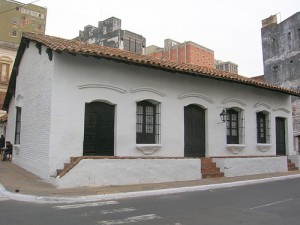 The Casa de la Independencia Museum is located in the oldest building in Asuncion. Built in 1772, the house was constructed of palm wood and bamboo and features adobe walls and a thatched roof. Although the house was used as a residence, it was the center of one of the most important events in Paraguay’s history.
The Casa de la Independencia Museum is located in the oldest building in Asuncion. Built in 1772, the house was constructed of palm wood and bamboo and features adobe walls and a thatched roof. Although the house was used as a residence, it was the center of one of the most important events in Paraguay’s history.
It was in this humble home that the emancipation from Spain was planned in secret meetings. On May 14, 1811, a group of brave patriots left the house at dawn and surrounded the house of the Spanish governor. They demanded that he relinquish control over the nation, the surrender was carried out without any bloodshed.
The museum is laid out in rooms as if the house was still a residence. There’s an office room that exhibits some of the important documents that were signed by various patriots that played a role in Paraguay’s independence. The dining room is decorated with furniture and other items, including a sword that belonged to Fulgencio Yegros, a main military figure in the 1811 revolution.
The bedroom still contains the bed that belonged to founding father, Fernando de la Mora. Below his portrait on a wall, is one of the shirts that he wore. The museums living room is decorated with French furniture and has a crystal chandelier. There are several full length portraits and religious carvings that were made in the Franciscan and Jesuit workshops.
An oratory displays even more carvings from the Franciscan’s and the Jesuit’s as well as various other religious objects from different origins. A large mural highlights the museum’s yard. There are various paragraphs of a note that ratified the nations independence, a coat of arms and a sundial from the Santa Rosa Jesuit Mission.
Another very interesting point in the yard is two tumulus’, or mounds. One of these mounds covers the body of the infamous patriot, Juan Bautista Rivarola Matto. He was a Paraguayan journalist, essayist, narrator and playwright. And, the other mound covers the body of Eusebio Ayala, a two time president of Paraguay.
Although the house kept the secrets of the plans for independence hidden, the alley way is probably even more significant. It was through this historical alley that the founding fathers were able to come and go without being seen. And, it was the alley that allowed Juana Maria de Lara to reach the Cathedral to have the bronze bells rang to summon the men to come and celebrate the birth of the new Republic of Paraguay early on May 15th.

{ 0 comments… add one now }